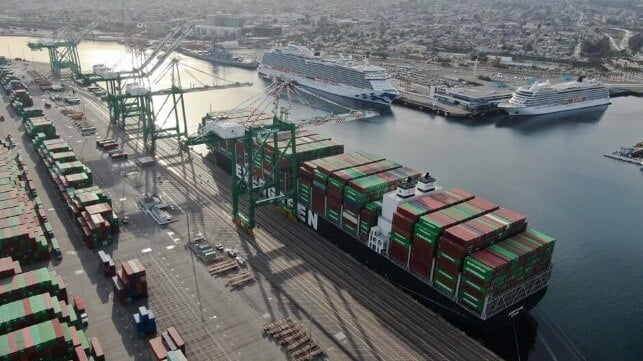Heat Wave Forces California to Suspend Shore Power Rules for Vessels

Faced with the prospect of a week-long heat wave bringing record-setting temperatures and straining the state’s power grid, California’s governor on Friday issued an executive order that among other steps suspends California’s requirement that ocean-going vessels use shore power in port. It was the first time in 2022 that the state took the action to reverse its increasingly tight emissions controls on vessels.
The move to suspend the shore power requirement for ships comes as the state’s independent power system operators issued pleas for conservation saying the power system was within its margin of capability. The call was for voluntary reductions by businesses and individuals with the power regulators saying otherwise there could be rolling blackouts across parts of the state. Individuals were asked to set their thermostats to 78 degrees F or higher, avoid using major appliances, and turn off unnecessary lights, especially during the peak hours between 4 p.m. to 9 p.m.
Power demand in California on Thursday evening reached its highest level in five years according to the California Independent System Operator association, while they said it was a rehearsal for what was to come. Temperatures were increasing with Sunday expected to be the hottest day but the heat wave is expected to not show signs of relief until Tuesday and not to return to more normal temperatures till late in the week. Temperatures in Northern California are forecast to be 10-20 degrees warmer than normal, and Southern California temperatures are expected to be 10-18 degrees warmer than normal, according to the National Weather Service. Sunday morning, temperatures near the ports of Long Beach and Los Angles were already in the high 90s F, the “feels like” at 110 degrees F in places, and forecasts to continue to rise a few more degrees.
California Governor Gavin Newsom proclaimed a state of emergency to temporarily increase energy production and reduce demand. The move included steps designed to allow power plants to generate additional electricity, permit the use of backup generators to reduce the amount of energy they need to draw from the grid and allow ships in California ports to reduce their consumption of electricity from the grid.
Due to the need to shed load from the power grid in what is likely to be a record heat wave in the western U.S., Newsom’s order included sections that withdrew and superseded regulations concerning the use of auxiliary engines by ocean-going vessels berthed in California ports, from Saturday, September 3, 2022, at 12:01 a.m., through Wednesday, September 7, 2022, at 11:59 p.m.
As part of its emissions controls, California requires passenger ships and containerships to use shore power or filters on the funnel’s emissions while docked in the ports including Los Angeles, Long Beach, and Oakland. According to the Marine Exchange of Southern California on Friday when the order was issued, there were a total of 55 vessels on dock in Los Angeles and Long Beach, including 20 containerships. On Sunday, the worst day of the heat wave, six containerships were scheduled to arrive and a total of seven ships. In addition to the power used by the ships plugging into the grid, the ports require large amounts of power for the cranes used to unload the containerships.
The power emergency however is counter to the emissions regulations which California is tightening on vessels. The current requirements for the use of shore power will be phased in to include car carriers and tankers and in a controversial move emission standards are also being extended to smaller commercial vessels, including harbor craft, requiring them to also limit emissions from their operations.
The governor noted that the state has added 4,000 MW of power to the grid in the last two years and has a contingency program supplying 2,000 MW through generators and other reserves to be used in emergencies such as the one the state faces with the current heat wave. California, however, needs to further expand its power supply including to offset a loss of hydropower due to the ongoing drought across the state.
